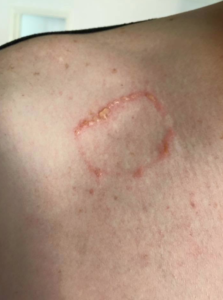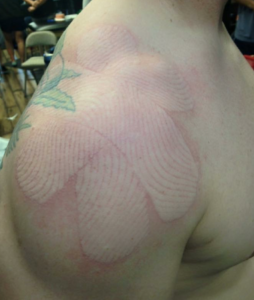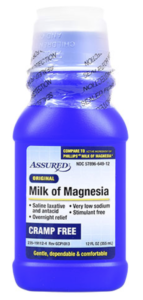 by Mitch Hauschildt, MA, ATC, CSCS
by Mitch Hauschildt, MA, ATC, CSCS
If you are reading this, you likely know that I love kinesiology tape (and specifically Rocktape). I use it at some point on just about every one of my patients and clients for improving a host of things. While it can’t cure cancer or fix stupid, I do find that when properly applied, kinesiology tape can make a big difference for a lot of the people we work with every day.
As much as I love it, there are some downsides and risks involved when using tape, namely the risk of skin irritations. Skin irritations can vary from minor redness and itching all the way up to large blisters and everything in between. They happen from time to time, so we need to let ourselves off the hook a bit when we encounter them because we can’t control or know everything all of the time. But, because we love our patients, and don’t want to harm them, we strive to minimize the risk of skin irritations as much as humanly possible.
Generally speaking, the risks of using tape are very small, but reducing this risk is worth revisiting from time to time to make sure that we take good care of our patients. Before we start with how to minimize the risks, let’s talk about what skin irritations look like and why they happen.
Types of skin irritation from tape:
- Redness and Itching: This is very common and I almost hesitate to call this a reaction. Many of our patients mistake increased sensory feedback and changes in bloodflow to an area with a skin irritations. Some itching and mild discomfort, especially in the short term, is oftentimes an indication that the tape is doing what it is supposed to do.

- Allergic Reaction: A true allergic reaction is pretty simple to recognize when you see it. You will see the outlines of the tape very easily and simply. It will be red and irritated right underneath the tape and around the edges and it will be uniform in nature. An interesting thing about allergic reactions is that some people will have an allergy on one part of their body but not another, so don’t throw all tape out the window because they reacted in one area of their body. Also keep in mind that different kinds of tape and band-aids use different types of adhesive. So, just because some is allergic to one kind of tape doesn’t mean that they will react to another brand or style.

- Blistering: This is the most concerning of all of the reactions because it is a true disruption of the skin and will take several days to weeks to heal. It can also be painful.
- Tearing: This usually occurs when the tape is removed and around the edges. It is also more common with geriatric and pediatric populations because of their thinner, more sensitive skin.
 Folliculitis: This is a pretty simple skin irritation where you will see redness and irritation around the hair follicles. This usually sticks around for a few days, but is oftentimes self limiting.
Folliculitis: This is a pretty simple skin irritation where you will see redness and irritation around the hair follicles. This usually sticks around for a few days, but is oftentimes self limiting.
Why do reactions happen?
There are a host of reasons that can lead to a skin reaction, but here is a list of the top reasons that I see that can cause skin irritations with tape. They are in no certain order, so any of these can be problematic.
- Allergy: Some people’s bodies just don’t like tape. This population is really small, but they do exist. What I find is that a lot of people who think they are allergic to tape don’t actually have an allergy. Rather, they just haven’t had it applied correctly, so when we make some adjustments to the application or the tape, they seem to do fine. If it is a true allergy, it is usually due to an intolerance to the glue, but there is a very small subset who react to a specific color of the tape. I don’t want to feed into the misconceptions that different colors are made differently or stick differently (they don’t), but I will tell you that there is a very small population to will react to certain dyes in colored tape. And, because there is different dyes in different colors, some people will react differently to one color versus another color.
- Too Much Stretch: This is the number one issue that I see with tape reactions. When you put stretch on the tape, you are asking for a skin irritation. This usually shows up as blistering or raised and inconsistent bumps on the skin.
- Poor Body Positioning During the Application: For the most part, it is less risky to apply tape with the tissue on stretch than with stretching the tape. Stretching out the tissue ensures that we won’t strain the skin while they perform athletic movements. The exception to this rule, of course, is when taping for postural control. With a posture application, we should place them in a “neutral” position and then tape them there. Problems arise when we are too aggressive with their position and/or we put stretch on the tape during a postural application. This will definitely strain the skin and cause an irritation.
- Wrong Tape: Rocktape has 3 different levels of adhesive. This is very intentional and for good reason. The standard adhesive works for most people and applications. The extra sticky is for heavy sweaters and people who are in the water a lot. The gentle version is designed for pediatrics, geriatrics and those with sensitive skin. Choosing an adhesive that is too strong, especially if they have thin or sensitive skin can lead to a skin irritation.
- Products on the skin: Even without tape, things like sunscreen, oils and chemicals on the skin can lead to blocked pores, pimples and irritated skin. Adding tape to that mix can cause breakouts that aren’t necessarily the fault of the tape, but they may appear to be broken out nonetheless.
- Poor removal habits: If the tape is removed abruptly, in the wrong direction, or without something to assist in emulsifying the glue, the tape can take skin with it. I usually see this when people decide to pull their tape off very fast, like removing a band-aid, or when young children take their tape off after only having it on for a day or so and they don’t use any oil or other product to break down the glue. This is painful, it will bleed and you won’t be able to re-tape them until it heals.
What are the solutions?
Now that we understand the what and why we encounter skin reactions, let’s talk about how we prevent them so we can use this awesome modality with a very minimal risk, which is the way it is supposed to be.
- Use a test patch: If you think you might want to use tape on someone and they have never had it before, throw a small piece on the inside of their forearm for 5-10 minutes. Remove it and inspect the skin for any allergic reaction. The inside of the forearm is a sensitive area of skin, so if they are going to break out, you will see it here. If you remove the tape and they haven’t shown a pretty significant reaction, then you should be safe to tape them.
- Use the proper tape: Assess your patient’s skin and use the proper tape. If you are worried about a reaction, use a more gentle tape. If they like it and the tolerate it, but it comes off faster than you want it to, then you can upgrade it to a stronger adhesive. It’s easier to go light to heavy than it is to go the opposite direction.
- Change the color: If they react to a specific color, consider taping them again with another color or the hemp version of Rocktape. Hemp tape doesn’t have any dyes in it, so it is very hypoallergenic. This will help you to avoid any issues with a color dye reaction.
- Less is more with regards to stretch: We teach this in all of our Rocktape courses, but it is worth revisiting. Always start with no stretch and consider applying stretch only after you know for sure that they will tolerate it. I would estimate that 95% of my taping applications have no stretch applied to the tape and have very few, if any skin reactions with my patients.
- Position them properly when applying tape: Whenever I can stretch the skin I will. You are always more safe to stretch the skin than the tape. When you are using a postural application, be sure to put them in a “neutral” position and nothing more. If their posture is really bad to start with, consider only taping them in a position that is closer to “normal” than where they started, even though it might not be optimal. Then work towards a “neutral” position over time so it is a gradual correction.
- Properly remove the tape: Always remove the tape slowly, in the direction of hair growth and if you are worried that it might take some skin with it, use baby oil directly on the tape to break down the glue. Taking the tape off too fast and in the wrong direction is one of the biggest culprits of skin reactions.

- Properly prepare the skin: First, the skin MUST be clean and dry. If they have lotions or oils on, it needs to be removed before applying tape. This not only aids in reducing risk, but it also increases the likelihood that the tape will stick. I always have a spray bottle of rubbing alcohol with me so I can quickly spray down the area and wipe it down, cleaning it really well. Also, Milk of Magnesia is my favorite skin prep. For people who have naturally oily skin, Milk of Magnesia will dry the skin out and help the tape to stick. For people who have thin or sensitive skin, Milk of Magnesia will provide a barrier to protect the skin. Simply paint 2-3 thin layers on the skin, allowing them to dry in between coats. Once it is dry you can tape right over top of it.
Overall, kinesiology tape is a very safe and effective tool to use for improving pain, movement and overall function. Any intervention has risks with it and the risks of taping are far smaller than other modalities, especially once you understand why skin reactions can occur and what to do to prevent them. I hope this helps you to feel confident in your taping techniques, ultimately benefiting those that you work with.


I have found with the pediatric population that taping around the neck area seems to be more sensitive than other areas of the body, so I will use MoM to help prep the skin there.
Thanks much for the information. I have had a problem with reaction to bandaids and sometimes rocktape over the years and doctors have pooh-poohed it..as maybe it’s latex ..I said the products are not latex containing. It usually occurs in the body areas where skin is more tender ..like inside the arm rather than on the tougher skin that’s more exposed to the environment. I.e., Rocktape on the front area of the knee rarely causes much reaction.
I will try some of your suggestions.
Hello,
I have a reaction and it looks like they are newly formed stretch marks that correspond with the pattern of the tape. Is there a possibility of this occurring or is it more likely a rash that will fade?
I would give it a few days to settle down and see if it resolves.
I had tape on the top & bottom of my forearm bc the therapist said my muscles were tight even though my injury was on the side of my arm. The tape caused a rash or bumps all over my arm where it was applied. I didn’t notice it until the tape came off. I was told to keep the tape on for 4 days & it actually made my arm pain worse. When tape was on it felt like it was squeezing my foarearm. I started get more pain, so I was adding the heating pad to relieve pain. After the 2nd day, I tried soaking in the bath to make the tape come off. But it seemed like it was super glued to my skin. I did this for 2 nights & the tape would never get loose. On the 4th day, I finally found a website that said to use baby oil, which after soaking for hours it finally came off. I ended up having worse problems in my forearm, hand & wrist. It’s now been a few weeks since the tape & my arm is still hurting. Does this normally happen with KT tape? I never had tape before, but I’m not sure why I got worse instead of better. What is tape supposed to help or do?
The tape can be used for a lot of different applications and purposes. There are a lot of variables at play depending on how the tape was applied with things like stretch and the type of tape and glue that was used. It does sound like you didn’t have a positive experience with tape. So, as much as I like tape and use it often, it isn’t for everyone. I might consider trying it again, depending on how it was applied and the desired outcome, but I would definitely let the area calm down before trying it again.
Thank you for the information. I just saw your reply. The tape started at bottom of my hand, down my forearm to the right side of my elbow bone(on the upper part of my arm). On the underside of my forearm, the tape went from the bottom of my palm, down forearm & slight past the crease of elbow. It was black tape w/ thinner white tape added around the wrist & my elbow on edges of the black tape.
Though it helped my neck pain alot.. I mean ALOT.. I did get some rashes and blistering. But I would still Recommend this product. I was in bad pain. So much I was in tears. I can deal with the rash and blistering ( the blister is in only in one area on my neck the rest are just rashes) because I know in time it will heal. But the pain I could not. Thank you for making such a great product that people like me can use.
i had to get my foot taped for football and had spray put on so the tape wouldn’t slip and after about a week or a week and a half there has been a reaction of some sort forming where it is red and itchy and has bumps and is causing my foot to swell and is spreading around the top of my foot and the front of my ankle. i don’t know what this is or what to do
That is likely a reaction to the tufskin spray that they used and not a product of the tape.
Thank you so much for all this helpful information and for all the tips and techniques! I found this extremely helpful and will be referring back to this article in the future and will share it too. I was worried that the reaction I had meant that I could no longer use the tape but now hopefully I can try different things and see if it works out better next time. Thanks again.
How long does it take for an allergic reaction to calm down? The reaction I have looks like red bumpy hives everywhere the tape was. You can easily distinguish the lines of the tape by the rash. It’s 12 hours after removing the tape and the rash it’s still there and it has a burning sensation to it. Is this something I need to go get care for from a doctor or will it go away on its own?
One more thing… what’s the difference between Rock tape and Kinesiology tape? Are they used for different things? Are they made differently?
I was using rock tape put on Me, by a professional physical therapist, for two weeks straight. tape was changed at each visit and on fourth visit. when He removed tape, I had serious red raised blisters that were extremely painful to the touch. He said no more tape for awhile. I am 68 years old and have shoulder impingement syndrome. so should I ask Him to use the lesser stick one for geriatric patients?